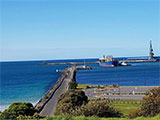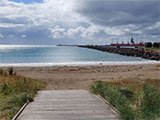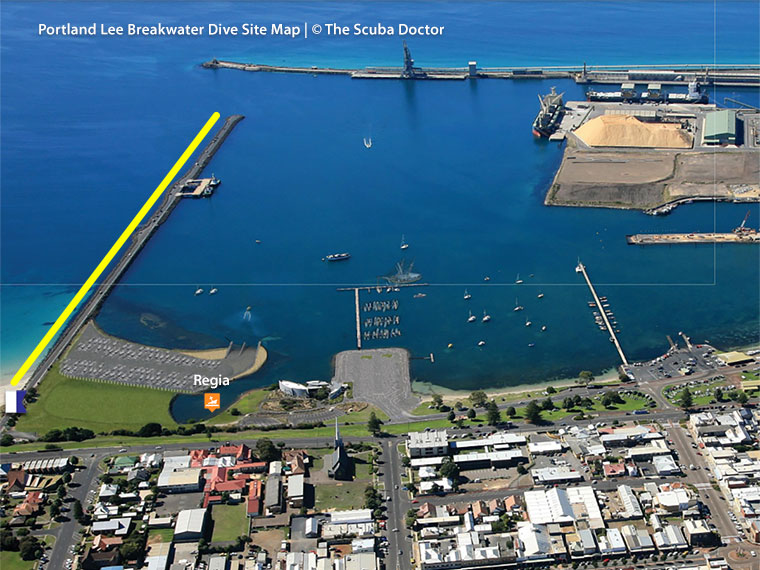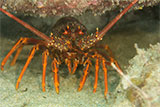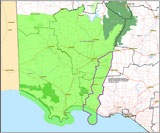Portland Lee Breakwater
![]() Shore Dive |
Shore Dive | ![]() Shore access
Shore access
![]()
![]()
![]()
![]()
Depth: 2 m (6.56 ft) to 14 m (46 ft)
Level: Open Water and beyond.
Portland Lee Breakwater is a shore diving and snorkelling site located in Portland, on Portland Bay (aka Henty Bay) on Victoria's Discovery Coast. The Lee Breakwater forms the northern boundary of the Portland harbour and runs in an east-west direction. It's 1,179 metres long and the far end is in 12 metres of water. The breakwater is a good night diving site and is a great dive for beginners as it's almost impossible to become disoriented.
Diving and Snorkelling the Portland Lee Breakwater
The rocky wall of Lee Breakwater is covered with a nice variety of seaweeds with plenty of temperate fish and small marine life. The weed is often sprinkled with sediment from port operations and an easterly swell stirs it up. The visibility is often from 2–5 metres depending on the day.
Fish species found here include Nudibranchs, Senator Wrasse, Bluethroat Wrasse, Scalyfin, Bluespotted Goatfish, smallSouthern Rock Lobster (aka Crayfish), Moonlighters, conger eels, the occasional Australian Fur Seals and stingrays. There are also seagrass beds nearby that offer slightly different species, including the prospect of seeing Weedy Seadragons. Other odd sightings include rainbowfish.
At night Little Penguins can often be seen on the breakwater. A fantastic night dive!
Diving is permitted on the outer (northern) side of the wall down to the pump house/wave marker around half way. Conditional diving is permitted beyond there to the end of the wall, but not when the S. L. Patterson Berth is in use.
Line fishing from the breakwater is very popular so be wary of monofilament, either broken-off or still active. Always take a dive knife and/or line cutter. Great place to find snagged swivels, lures, sinkers, etc.
Location: Lee Breakwater Road, Portland, Victoria 3305
Parking: The best parking is on Lee Breakwater Road, just north of the breakwater. Vehicles can also be parked along the breakwater.
Facilities: Toilets, showers and changerooms are available at the shore end of the breakwater.
Safety First: Beware of fishing line as the breakwater is a popular fishing spot. Always carry a good dive knife and/or line cutter. This area is frequented by boats, so please make sure you display your dive flag in this area.
Entry/exit: It's best to enter and exit the water from Nuns Beach on the northern side of the breakwater. Some intrepid souls are known to scramble down the northern side of the breakwater rock wall. Be careful as the rock wall is steep and slippery. Recreational diving within the boundaries of the breakwaters of Port of Portland is prohibited. Recreational diving from the outer breakwaters is prohibited without a prior permit from Port of Portland.
Ideal Conditions: Portland Lee Breakwater is sheltered from westerly to southerly swells by the main breakwater to the south. It is also well protected by winds from most directions, however, easterlies are not favourable to this location. See WillyWeather (Portland) as a guide for the tide times and the height of the tide.
{{sally-watson}}Divers have the opportunity to catch Southern Rock Lobster (aka Crayfish) at this dive site. Remember your catch bag, current Victorian Recreational Fishing Licence, rock lobster measure, and cray tags. Once you get back to the dive boat, or shore, make sure you clip the tail and tag your Crayfish as per Fisheries requirements. Please abide by all current fishing regulations if you intend to catch crays. See article-catching-crayfish for practical cray hunting advice from The Scuba Doctor, plus melbourne-cray-dives for a list of other crayfish dive sites near Melbourne. For tips on cooking your Crays, please see article-cooking-crayfish.
Spearfishing is illegal within 30 metres of any pier or jetty and in Marine National Parks. See Spearfishing Laws.
Traditional Owners — This dive site is in the traditional Country of the Gunditjmara people of far south-western Victoria which continues over the state border into a small part of south-east South Australia and is bordered by the Glenelg River to the west and the Wannon River in the north. This truly ancient Country extends 100 metres out to sea from low tide and also includes Deen Maar (aka Lady Julia Percy Island) where the Gunditjmara believe the spirits of their dead travel to wait to be reborn. We wish to acknowledge the Gunditjmara as Traditional Owners. We pay respect to their Ancestors and their Elders, past, present and emerging.
Portland Lee Breakwater Location Map
Latitude: 38° 20.595′ S (38.343251° S / 38° 20′ 35.7″ S)
Longitude: 141° 36.485′ E (141.608081° E / 141° 36′ 29.09″ E)
Datum: WGS84 |
Google Map
| Get directions
Added: 2021-07-21 03:50:13 GMT, Last updated: 2022-05-24 12:48:39 GMT
Source: Google Earth
Nearest Neighbour: Nuns Beach, 54 m, bearing 6°, N
Portland, Discovery Coast.
Depth: 1 to 14 m.
[ Top ]
DISCLAIMER: No claim is made by The Scuba Doctor as to the accuracy of the dive site coordinates listed here. Should anyone decide to use these GPS marks to locate and dive on a site, they do so entirely at their own risk. Always verify against other sources.
The marks come from numerous sources including commercial operators, independent dive clubs, reference works, and active divers. Some are known to be accurate, while others may not be. Some GPS marks may even have come from maps using the AGD66 datum, and thus may need be converted to the WGS84 datum. To distinguish between the possible accuracy of the dive site marks, we've tried to give each mark a source of GPS, Google Earth, or unknown.

